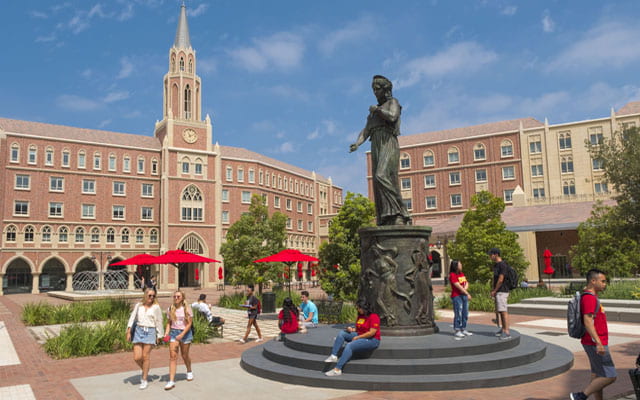September 29, 2017
This fall semester, we have been so gratified to see how quickly and enthusiastically our new USC Village has been embraced—not only by our students, faculty, and staff, but by our local community, alumni, and friends. Throughout the day, the central piazza is bustling with life, as students share meals at the tables, pose for selfies in front of Hecuba, or sit along the edge of the Fubon Fountain. There’s a steady flow of shoppers at Trader Joe’s, which along with Target has quickly become a much-loved go-to store for local residents. This project was seven years in the making, so it’s wonderful to see so many enjoying the buildings and patios, dining hall, fitness center, green spaces, and shops. Without question, it has profoundly transformed the experience USC offers its students.
Beyond the practical, the USC Village is also beautiful. The Architect’s Newspaper published an in-depth story on its design, and focused on our decision to develop the property on our own land and with our own resources, approaching the project as an expansion of our University Park Campus. This decision, the writer noted, benefitted the project in key ways. “For one, the buildings stand taller and prouder than would normally be the case,” he wrote. “A central bosque adjacent to the main plaza… serves to cool the main square and aligns with one of the university’s main axes, mirroring the tree allées across the street on the main campus.” Internationally, the USC Village has also received considerable press, with lengthy stories appearing in China’s Global Times and in Mexico’s Reforma.
To e or not to e?
When we unveiled our new Hecuba statue at the heart of the USC Village, a detail on its base drew particular attention: namely, the spelling of Shakespeare. In omitting the final “e,” Christopher Slatoff, the artist, embraced a less common spelling that had become popular in the eighteenth century. The choice generated some gentle ribbing and plenty of Instagram posts, and yet a story in The Guardian quoted a Renaissance scholar in the United Kingdom, who pointed out that there is a “lot of variation in the way the name is spelled when it appears in contemporary legal documents and the early printed texts of Shakespeare’s works.” The article concluded with praise for our spelling, and quoted from a statement released by our public relations staff: “Over the centuries (Shakespeare’s) surname has been spelled 20 different ways. USC chose an older spelling because of the ancient feel of the statue.”
Intellectual property course at USC
While we set new standards in student residential life, we also continue to innovate in our academic programs. USC is now offering one of the first undergraduate courses on the basic workings of patents, copyrights, trademarks, and trade secrets: “The Entrepreneur’s Guide to Intellectual Property.” This is a much-needed course in our society’s educational landscape. Dr. Gary Michelson, the namesake of our USC Michelson Center for Convergent Bioscience, and I recently wrote an op-ed, in which we discussed the need for teaching the next generation of students about the importance of intellectual property, and called for universities to address the growing intellectual property education gap. At our own university, this course is particularly timely: the USC Michelson Center—which formally opens on November 1—will pioneer new life-saving technologies and treatments, a task that would be impossible without the patents that drive nearly all investment in biotech research.
Urging action on DACA
As the federal government works to find a long-term solution to the Deferred Action for Childhood Arrivals (DACA), and as the complexities of this issue fuel discussions throughout the United States, I recently contributed an op-ed to The Hill, in which I underscored the importance of undocumented American students to university communities—including USC’s—and the urgency of Congressional action. Not only do I argue for a humane approach, but I point out that the reversal of DACA means that our nation would have invested in the education of tens of thousands of university graduates, and yet we would be walking away from the enormous economic and cultural benefits that this investment would bring.
Jake Olson and the Trojan spirit
Our football season began with an inspired win over Western Michigan, but perhaps the most inspiring moment from that game came near the end, when student-athlete Jake Olson completed a perfect snap for an extra point. What made this moment so special was Jake’s longstanding admiration for Trojan football, and the fact that he completed this pass so spectacularly, despite having lost his sight as a young boy. He is now a business major at USC and proud member of our football team as a long snapper. His determination to pursue his childhood dream of playing football for USC reflects his Trojan spirit, and reminds us all of the noblest qualities of our community. We were so pleased to see the wonderful and well-deserved attention he has received. Fight On!
Next month, I will share highlights from our USC Global Conference in Tokyo. In the meantime, Niki and I wish you a wonderful fall season.
Yours truly,
C. L. Max Nikias
President
